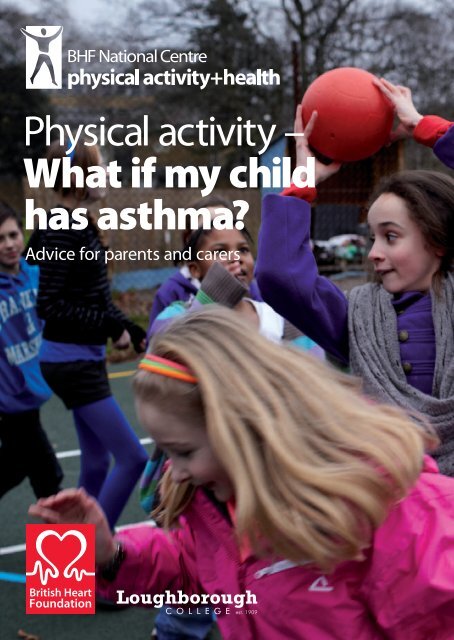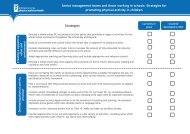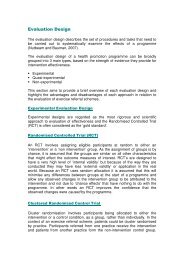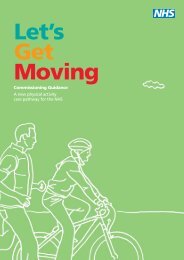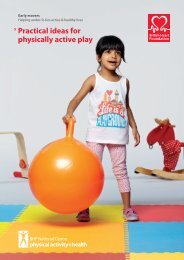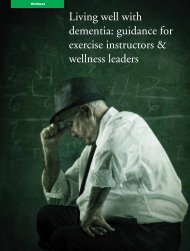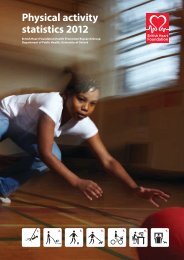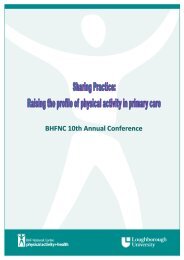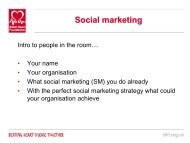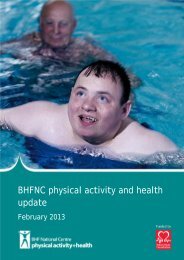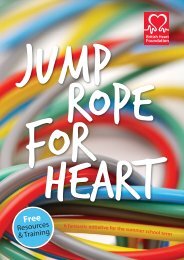Physical activity – What if my child has asthma? - BHF National ...
Physical activity – What if my child has asthma? - BHF National ...
Physical activity – What if my child has asthma? - BHF National ...
Create successful ePaper yourself
Turn your PDF publications into a flip-book with our unique Google optimized e-Paper software.
<strong>Physical</strong> <strong>activity</strong> –<strong>What</strong> <strong>if</strong> <strong>my</strong> <strong>child</strong><strong>has</strong> <strong>asthma</strong>?Advice for parents and carers
If you havea <strong>child</strong> who<strong>has</strong> <strong>asthma</strong>,this bookletis for you.This booklet does not replace the advicethat health professionals involved in the careof your <strong>child</strong> may give, as they know moreabout your <strong>child</strong>’s condition.ContentsAbout this booklet 5Is it safe for <strong>my</strong> <strong>child</strong> to do physical <strong>activity</strong>? 6How much physical <strong>activity</strong> should <strong>my</strong> <strong>child</strong> do? 7<strong>What</strong> are the benefits of regular physical <strong>activity</strong>for <strong>my</strong> <strong>child</strong>? 9<strong>What</strong> can I do to help? 12Are some types of physical <strong>activity</strong> better thanothers for people with <strong>asthma</strong>? 20Are there any types of physical <strong>activity</strong> that <strong>my</strong><strong>child</strong> should avoid? 24<strong>What</strong> about taking part in PE, sports andphysical <strong>activity</strong> at school? 26<strong>What</strong> are the symptoms to look out for when<strong>my</strong> <strong>child</strong> is active? 28<strong>What</strong> else can I do to encourage <strong>my</strong> <strong>child</strong>to be active? 30For more information 34
About this bookletIf you have a <strong>child</strong> who <strong>has</strong> <strong>asthma</strong>,this booklet is for you.The booklet:❤❤explains why it is good for your <strong>child</strong>to be physically active❤❤provides information to help you makeit easy and enjoyable for your <strong>child</strong> tobe active safely❤❤aims to make sure your <strong>child</strong> is not putoff being active❤❤looks at the worries that you or your<strong>child</strong> may have about physical <strong>activity</strong>and how they can be overcome.5
Is it safe for <strong>my</strong> <strong>child</strong>to do physical <strong>activity</strong>?Yes. There are very few <strong>child</strong>ren and young people whowill be advised not to do any physical <strong>activity</strong>. Many peoplewrongly think that physical <strong>activity</strong> is not safe for anyonewith <strong>asthma</strong> because it can trigger their <strong>asthma</strong> symptoms.For some <strong>child</strong>ren and young people, physical <strong>activity</strong>may be the only trigger of their <strong>asthma</strong>. This is known as‘exercise‐induced <strong>asthma</strong>’. For others, physical <strong>activity</strong> maybe one of several triggers. And for others, physical <strong>activity</strong> isnot a trigger at all.If physical <strong>activity</strong> is a trigger for your <strong>child</strong>, it is understandablethat you may worry about them taking part in physical<strong>activity</strong> and getting out of breath. But as long as your <strong>child</strong>’s<strong>asthma</strong> is under control, they can take part in any physical<strong>activity</strong> they enjoy.Every <strong>child</strong> is d<strong>if</strong>ferent and most <strong>child</strong>ren and young peoplewho have <strong>asthma</strong> will know their triggers and limitations.However, you might want to get advice about your <strong>child</strong>’scondition before encouraging your <strong>child</strong> to become moreactive. Your <strong>child</strong>’s healthcare professionals should be ableto advise you <strong>if</strong> there are any particular activities that your<strong>child</strong> should avoid.How much physical<strong>activity</strong> should <strong>my</strong><strong>child</strong> do?To improve health, experts recommend that all <strong>child</strong>renand young people aged 5-17 years should do at least60 minutes of moderate to vigorous intensity physical<strong>activity</strong> every day. This applies to all <strong>child</strong>ren and youngpeople, including those who have <strong>asthma</strong>.Moderate-intensity <strong>activity</strong> is <strong>activity</strong> that may raise your<strong>child</strong>’s pulse, and make them breathe slightly faster and feela little warmer – for example, brisk walking, steady cycling,roller-skating or active play.Vigorous-intensity <strong>activity</strong> is <strong>activity</strong> that makes your <strong>child</strong>‘huff and puff’ and makes them feel sweaty – for example,organised games such as football and netball as well asactivities such as running, fast cycling, swimming laps,and jumping and climbing over obstacles.67
The 60 minutes <strong>activity</strong> doesn’t have to be done all at once.It can be spread across the whole day by doing severalshorter amounts of <strong>activity</strong> – for example, two short boutsof 15 minutes <strong>activity</strong> running around in the playground,combined with a longer bout of programmed <strong>activity</strong> suc<strong>has</strong> PE or supervised recreational <strong>activity</strong>.If your <strong>child</strong> is currently inactive, they should graduallyincrease the amount of physical <strong>activity</strong> they do, and shouldaim to eventually achieve the 60 minutes a day target. If your<strong>child</strong> is currently not doing any physical <strong>activity</strong>, doing some<strong>activity</strong> – even <strong>if</strong> it’s below the recommended level – willbring more benefits than doing no physical <strong>activity</strong> at all.Any physical <strong>activity</strong> is better than none, and generally themore the better.<strong>What</strong> are the benefitsof regular physical<strong>activity</strong> for <strong>my</strong> <strong>child</strong>?There is lots of evidence that <strong>child</strong>ren and young peoplebenefit from being physically active. This applies to all<strong>child</strong>ren and young people, including those with <strong>asthma</strong>.Regular physical <strong>activity</strong> can:❤❤promote healthy growth and development❤❤help keep the heart and lungs healthy❤❤help develop strong muscles and bones❤❤improve balance and flexibility❤❤help achieve and maintain a healthy body weight❤❤make them feel good, improve their mood and helpthem cope with the stresses of everyday l<strong>if</strong>e❤❤improve self-esteem and body image❤❤provide opportunities to make friends❤❤build confidence and help develop social skills.8 9
As well as the benefits listed on the previous page, regularphysical <strong>activity</strong> <strong>has</strong> the following important benefits for<strong>child</strong>ren and young people with <strong>asthma</strong>.❤❤It can help improve lung function by strengthening thebreathing muscles in the chest. This can have importantlong-term effects on breathing and <strong>asthma</strong> control.❤❤It can help your <strong>child</strong> to manage their <strong>asthma</strong> betterduring periods of physical <strong>activity</strong>, as they have increasedlung capacity and better fitness.❤❤It can help your <strong>child</strong> to cope better with everydayactivities, as they will have more stamina.❤❤It helps reduce any anxieties your <strong>child</strong> may haveabout their <strong>asthma</strong>, and give them confidence tomanage their condition.❤❤It can help your <strong>child</strong> reach or keep to a healthyweight. This is particularly important, as <strong>child</strong>ren andyoung people who are overweight often need to takemore medicine to control their <strong>asthma</strong>, and their <strong>asthma</strong>is usually less well controlled.10
<strong>What</strong> can I do to help?All <strong>child</strong>ren and young people should try to do regularphysical <strong>activity</strong>. However, <strong>if</strong> your <strong>child</strong>’s <strong>asthma</strong> is poorlycontrolled, they should see their doctor or <strong>asthma</strong> nursebefore they start becoming more active.We can all play a vital role in supporting and encouraging<strong>child</strong>ren and young people to be more active.Be positive about your <strong>child</strong>’s condition.❤❤Don’t let <strong>asthma</strong> be an obstacle to your <strong>child</strong> beingactive. Many Olympic athletes, professional footballersand other high-level sportspeople have <strong>asthma</strong> – forexample, Olympic swimmer Rebecca Adlington, therunner Paula Radcl<strong>if</strong>fe, and the footballer Paul Scholes.Make sure your <strong>child</strong> is adequately preparedfor physical <strong>activity</strong>.❤❤Make sure your <strong>child</strong> takes their <strong>asthma</strong> medicinecorrectly and regularly. Explain to them why thisis important.❤❤Make sure your <strong>child</strong> <strong>has</strong> their reliever inhaler (usuallya blue inhaler), and their spacer <strong>if</strong> they use one, closeby them during physical <strong>activity</strong>.❤❤If your <strong>child</strong>’s <strong>asthma</strong> is triggered by physical <strong>activity</strong>(exercise-induced <strong>asthma</strong>), make sure they take theirreliever inhaler about 5 minutes before they begin the<strong>activity</strong>. The symptoms of exercise-induced <strong>asthma</strong> maystart shortly after physical <strong>activity</strong> begins and usually getworse about 15 minutes after the physical <strong>activity</strong> <strong>has</strong>stopped. Taking their reliever inhaler before doing the<strong>activity</strong> can help prevent them getting these symptoms.❤❤Teach your <strong>child</strong> to stop being physically active as soonas they experience any symptoms of <strong>asthma</strong>, and totake their reliever inhaler. They can return to light <strong>activity</strong>once they feel fully recovered. They should wait at least5 minutes. Sometimes high doses from the reliever canslightly increase the <strong>child</strong>’s heartbeat or result inmild muscle shakes, but these effects are harmlessand generally wear off after a short time.12 13
Try a range of d<strong>if</strong>ferent activities.There are lots of d<strong>if</strong>ferent ways to be active and most <strong>child</strong>renand young people will be keen to try out new activities.❤❤Encourage your <strong>child</strong> to try a range of d<strong>if</strong>ferent physicalactivities to find out which ones they enjoy and whichones they can cope with better.❤❤Trying out d<strong>if</strong>ferent activities will help your <strong>child</strong>understand how their body responds to various typesof physical <strong>activity</strong>. This is all part of them learning howto manage their <strong>asthma</strong>.Try to be more active as a family.Children and young people who have physically activeparents are more likely to be active themselves.❤❤Be a good role model for your <strong>child</strong>. For example, simplywalking more often can help your <strong>child</strong> see that youvalue physical <strong>activity</strong>.❤❤Make time to be active and have fun as a family. Forexample, go for a walk, play frisbee, have a kick-aboutin the garden or local park, or perhaps go swimmingtogether.❤❤Providing opportunities for your <strong>child</strong> to be activewith you may help build their confidence about beingphysically active with friends, and reassure them thatit is safe for them to be active.14 15
Teach your <strong>child</strong> to warm up and cool down.Your <strong>child</strong> should always warm up for at least10 minutes before physical <strong>activity</strong> and cool downgradually afterwards.Warming up means beginning physical <strong>activity</strong> slowlyand building up gradually. Cooling down means taking timeto slow down and not stopping physical <strong>activity</strong> suddenly.An extended warm-up and gradual cool-down areimportant. They help slow the change of air temperaturein the airways. This may help reduce the likelihood of your<strong>child</strong> developing <strong>asthma</strong> symptoms and will help keeptheir symptoms under control.16
Try to reduce your <strong>child</strong>’s exposure to triggers.It can be d<strong>if</strong>ficult to ident<strong>if</strong>y exactly what triggers your<strong>child</strong>’s <strong>asthma</strong>.❤❤If you’re aware of any triggers to your <strong>child</strong>’s <strong>asthma</strong>,teach your <strong>child</strong> how they can avoid these. For example,in cold weather, make sure your <strong>child</strong> covers their noseand mouth with a scarf. In summer, avoid outdooractivities when pollen levels are high or duringgrass cutting.❤❤Avoiding triggers applies not just to when your <strong>child</strong>is being active. It also includes things like avoidingpets <strong>if</strong> your <strong>child</strong> is allergic to them, and avoidingcigarette smoke.Arrange regular <strong>asthma</strong> reviews withyour <strong>child</strong>’s doctor or <strong>asthma</strong> nurse.❤❤Arrange a regular <strong>asthma</strong> review with your <strong>child</strong>’s doctoror <strong>asthma</strong> nurse. Your <strong>child</strong> should have a review at leastonce every six months, depending on their conditionand how well their <strong>asthma</strong> is controlled.❤❤Make sure you have a personal <strong>asthma</strong> plan for your <strong>child</strong>.❤❤You may find it useful to fill in a School Asthma Card withthe help of your doctor or <strong>asthma</strong> nurse, and to give thisto your <strong>child</strong>’s nursery, school or physical <strong>activity</strong> leaders.(See page 27.)Keep a record of what triggers your<strong>child</strong>’s <strong>asthma</strong>.❤❤It may be a good idea for your <strong>child</strong> to keep a diary ofany symptoms (such as wheezing, coughing, tightnessin the chest, or d<strong>if</strong>ficulty breathing) together with anypotential triggers they have been exposed to (such aspollen, traffic fumes or pets, or <strong>if</strong> they have a cold orcough). If your <strong>child</strong> is too young to do this themselves,you could keep a diary for your <strong>child</strong>. You may find ithelpful to bring this diary along to the regular <strong>asthma</strong>reviews your <strong>child</strong> <strong>has</strong> (see the next page).18 19
Are some types ofphysical <strong>activity</strong> betterthan others for peoplewith <strong>asthma</strong>?You may need to think about the type of physical <strong>activity</strong>that your <strong>child</strong> can do, especially <strong>if</strong> your <strong>child</strong> is very limitedby their <strong>asthma</strong> symptoms. Certain types of physical <strong>activity</strong>may be better suited to your <strong>child</strong> than others. But as long asyour <strong>child</strong>’s <strong>asthma</strong> is under control, they can take part in anyphysical <strong>activity</strong> they enjoy.Dynamic aerobic activities – such as walking, cycling,swimming, dancing, fitness classes and adapted team games– are generally better for <strong>child</strong>ren and young people wit<strong>has</strong>thma, as these can be done at low intensity and intermittently.Also, <strong>child</strong>ren and young people with <strong>asthma</strong> tend to cope betterwith ‘interval-type activities’. That means activities that requirebursts of <strong>activity</strong> interspersed with spells of <strong>activity</strong> at a slowerpace – for example, relay races, tag or c<strong>has</strong>ing or jumping games.With this type of <strong>activity</strong>, the <strong>child</strong> or young person can rest inbetween bursts of <strong>activity</strong>. Interval-type activities can be usedto slowly improve your <strong>child</strong>’s stamina, without causing themdiscomfort. At first your <strong>child</strong> may need longer rest periods,but these can be made shorter as their stamina improves.Activities with rest periods should still involve somemovement, but at a slower pace. This is known as ‘activerest’. Complete rest in between bursts of <strong>activity</strong> is notrecommended.Indoor swimmingRecreational indoor swimming is an excellent <strong>activity</strong> for<strong>child</strong>ren and young people with <strong>asthma</strong>, as they can doit at their own pace. Also, the warm, humid air in theswimming pool is less likely to trigger your <strong>child</strong>’s <strong>asthma</strong>symptoms. However, your <strong>child</strong> should take care in heavilychlorinated or very cold pools, as these can be a triggerto <strong>asthma</strong> symptoms for some <strong>child</strong>ren and young people.Team gamesTeam games such as football, hockey, netball or volleyballare good activities for <strong>child</strong>ren and young people wit<strong>has</strong>thma because they tend to involve brief bursts of playingat a higher intensity followed by active rest periods, so theyare less likely to cause <strong>asthma</strong> symptoms. Some <strong>child</strong>renand young people with <strong>asthma</strong> may struggle to completea full game, but may be able to cope with an adapted game– for example, having more players on each team, or usinga smaller play area.20 21
Racquet and net gamesRacquet and net games such as badminton or table tennisare ideal activities for <strong>child</strong>ren and young people wit<strong>has</strong>thma, as they involve brief bursts of <strong>activity</strong>. Badmintonis ideal as the shuttlecock travels slowly and the court isquite small. Tennis and squash usually involve more constant<strong>activity</strong> and are faster paced. Your <strong>child</strong> may struggle to copewith a full game of tennis, but may find short tennis easier.Striking and fielding gamesActivities such as cricket, softball and rounders may be idealfor <strong>child</strong>ren and young people with <strong>asthma</strong>. These gamestend to include brief bursts of <strong>activity</strong> followed by shortbreaks. Also, the pace of the game can be adapted to suitd<strong>if</strong>ferent abilities.Yoga, pilates and T’ai ChiThese are excellent activities for <strong>child</strong>ren and youngpeople with <strong>asthma</strong>, as they relax the body and mayhelp with breathing.Cycling, rollerblading and skateboardingThese activities can be great fun. They are perfect for<strong>child</strong>ren and young people with <strong>asthma</strong> as they can controlhow fast or how slow they want to go!Every <strong>child</strong>’s and young person’s condition is d<strong>if</strong>ferent.If you have any concerns or queries about your <strong>child</strong>being active, always ask your <strong>child</strong>’s doctor or <strong>asthma</strong>nurse.Gymnastics and dancingChildren and young people with <strong>asthma</strong> rarely experienceany d<strong>if</strong>ficulties with gymnastics, aerobic dance or dancing.These are ideal activities, as they lend themselves to briefbursts of <strong>activity</strong>. Your <strong>child</strong> can set their own pace and caninclude active rest periods (see page 21).Complete rest in between bursts of <strong>activity</strong> is notadvised, as this can trigger exercise-induced <strong>asthma</strong>.22 23
Are there any typesof physical <strong>activity</strong> that<strong>my</strong> <strong>child</strong> should avoid?Some types of physical <strong>activity</strong> may present problemsfor some <strong>child</strong>ren and young people with <strong>asthma</strong> due tothe environment in which they take place – for example,long-distance or cross-country running, adventure sportsor outdoor activities.❤❤Long-distance or cross-country running can be astrong <strong>asthma</strong> trigger because they are done outside,sometimes in cold air and without rest breaks. Thereis also less opportunity to see how the <strong>child</strong> or youngperson is coping with the <strong>activity</strong>.❤❤Some adventure sports or outdoor activities may bringon <strong>asthma</strong> symptoms. This is more likely to be related toemotional or environmental factors associated with the<strong>activity</strong> than the <strong>activity</strong> itself – for example, excitement,anxiety, stress, weather, high pollen count and altitude.Asthma UK recommends that you contact your <strong>child</strong>’sdoctor and seek advice before your <strong>child</strong> takes part inany adventure sports.24
<strong>What</strong> about taking partin PE, sports and physical<strong>activity</strong> at school?Taking part in <strong>Physical</strong> Education (PE) and other physicalactivities at school is important for your <strong>child</strong>, both for theirlong-term health and well-being and to make sure theyare fully involved in school l<strong>if</strong>e.How you can help❤❤Teach your <strong>child</strong> the importance of taking part in PEand physical <strong>activity</strong> at school and in after-school clubs.Encourage them to take part at their own pace andwithin their own limitations.❤❤Remind your <strong>child</strong> to take their medicines regularly,especially their preventer inhaler, and to keep their relieverinhaler (usually blue) and spacer with them at all times.❤❤Make sure that the school always <strong>has</strong> a spare relieverinhaler and spacer for your <strong>child</strong>. Check the expiry dateon inhalers regularly and replace them when needed.❤❤Keep your <strong>child</strong>’s teachers and physical <strong>activity</strong> leaders(for example, after-school club leaders or sports coaches)informed about your <strong>child</strong>’s <strong>asthma</strong>, particularly aboutwhat triggers their <strong>asthma</strong> and how best to avoid those26triggers. Make sure your <strong>child</strong>’s nursery, school orphysical <strong>activity</strong> leader <strong>has</strong> written information aboutyour <strong>child</strong>’s triggers and symptoms, their inhaler, youremergency contact details and how to recognise <strong>if</strong> your<strong>child</strong> is having an <strong>asthma</strong> attack and what to do about it.Asthma UK produces a School Asthma Card and aPre-school Asthma Card, which are ideal for this.They also produce an Asthma Attack Card which can beused by physical <strong>activity</strong> leaders. To order these, visitwww.<strong>asthma</strong>.org.uk or call Asthma UK on 0800 121 6255.❤❤Let your <strong>child</strong>’s teachers and physical <strong>activity</strong> leadersknow about any recent <strong>asthma</strong> attacks your <strong>child</strong> <strong>has</strong>had, or changes in their condition or medicines. Makesure their personal <strong>asthma</strong> plan or School Asthma Cardis updated or exchanged.❤❤It might help put your mind at rest <strong>if</strong> you discuss anyconcerns you have regarding your <strong>child</strong>’s involvementin PE with your <strong>child</strong>’s teacher or school nurse.❤❤Ask about the school’s <strong>asthma</strong> policy (or their medicalconditions policy). For example, you might want toask about their policy on access and storage of pupils’inhalers; whether staff have had training in <strong>asthma</strong>awareness (knowing what to do <strong>if</strong> a <strong>child</strong> <strong>has</strong> an <strong>asthma</strong>attack, and how to avoid <strong>asthma</strong> triggers); or whetherteachers will always let parents or carers know <strong>if</strong> a <strong>child</strong><strong>has</strong> an <strong>asthma</strong> attack or <strong>has</strong> needed to use their relieverinhaler more often than usual during school time.27
<strong>What</strong> are the symptomsto look out for when <strong>my</strong><strong>child</strong> is active?It’s OK and ‘normal’ for your <strong>child</strong> to feel warm, breatheharder, look ‘flushed’ and feel his or her heart beat fasterduring physical <strong>activity</strong>.Your <strong>child</strong> should stop doing the <strong>activity</strong><strong>if</strong> he or she:❤❤starts coughing or wheezing❤❤starts to become short of breath❤❤feels tightness in the chest❤❤<strong>has</strong> d<strong>if</strong>ficulty speaking in short sentences❤❤is unusually quiet and quite still❤❤<strong>has</strong> tum<strong>my</strong> ache (sometimes in younger <strong>child</strong>ren)❤❤<strong>has</strong> cyanosis (a blue tinge to the skin or lips). This is a signof a lack of oxygen in the blood, and indicates the needfor urgent medical attention.Your <strong>child</strong> may not have all of these symptoms. Also,how severe the symptoms are and how long they lastfor may vary greatly between separate <strong>asthma</strong> attacks.<strong>What</strong> to doIf you notice any of the signs or symptoms opposite:❤❤Get your <strong>child</strong> to stop and rest immediately.❤❤Never push your <strong>child</strong> to continue their <strong>activity</strong>. Asthmasymptoms will often get worse once <strong>activity</strong> is stopped,so insisting that your <strong>child</strong> keeps going until they areforced to rest can be dangerous.❤❤Give your <strong>child</strong> one or two puffs of their reliever inhaler(usually blue) immediately, preferably through a spacer.❤❤Sit your <strong>child</strong> up and slightly forward. Don’t lie themdown or hug them.❤❤Encourage them to take slow, steady breaths.❤❤Loosen tight clothing.❤❤Stay with them and reassure them.❤❤If there is no immediate improvement, continue to makesure your <strong>child</strong> takes two puffs of their reliever inhalerevery two minutes, taking up to 10 puffs.❤❤If your <strong>child</strong>’s symptoms don’t improve after 10 puffs, or<strong>if</strong> you are worried at any time, call 999 for an ambulance.❤❤If an ambulance does not arrive within 15 minutes andyour <strong>child</strong> is not improving, give further doses of theirreliever inhaler. Make sure your <strong>child</strong> takes two puffs oftheir reliever every two minutes, taking up to 10 puffs.Asthma 28 29
<strong>What</strong> else can I doto encourage <strong>my</strong> <strong>child</strong>to be active?❤❤Teach your <strong>child</strong> to slowly build up the amount ofphysical <strong>activity</strong> they do.❤❤Encourage your <strong>child</strong> to be physically active throughoutthe day, aiming for at least 60 minutes of physical <strong>activity</strong>every day.❤❤Choose physical <strong>activity</strong> carefully. Try to match activitiesto your <strong>child</strong>’s likes, needs and abilities, so they don’tbecome disheartened over any d<strong>if</strong>ficulties anddiscomforts.❤❤Remember that your <strong>child</strong> doesn’t have to be ‘sporty’or join a team or a gym in order to take part in physical<strong>activity</strong>. Walking or dancing to their favourite music areexcellent forms of physical <strong>activity</strong> and cost nothing.❤❤Find d<strong>if</strong>ferent ways of keeping your <strong>child</strong> active, andencourage them to take part in activities they enjoy.❤❤Encourage your <strong>child</strong> to try out new activities withtheir friends.❤❤Try to limit the amount of time that your <strong>child</strong> spendson sitting-down activities – such as watching TV or DVDs,or playing computer games – to no more than twohours a day.❤❤Set a good example and try to be more active as a family.Where possible, allow your <strong>child</strong> to walk or cycle to theshops and school.❤❤Praise and reward your <strong>child</strong> for being active. Be positiveabout their achievements, big or small, and reward themfor persistence and taking part.30 31
Remember:It’s important to encourage your <strong>child</strong>to take part in physical activities thatare appropriate for them. Activitiesshould be enjoyable and offer variety.Some physical <strong>activity</strong> is better thannothing at all! And generally the morethe better.33
For more informationAsthmaAsthma UKwww.<strong>asthma</strong>.org.ukAsthma UK Adviceline: 0800 121 6244Asthma UK is the charity dedicated to improving the healthand well-being of the 5.4 million people in the UK whose livesare affected by <strong>asthma</strong>.Encouraging your <strong>child</strong> to be more activePublicationsGet Kids on the Go<strong>BHF</strong> <strong>National</strong> Centre for <strong>Physical</strong> Activity and HealthThis booklet includes tips and tools for encouraging<strong>child</strong>ren to be active.Active Placeswww.activeplaces.comA website that allows you to search for sports facilities anywherein England.<strong>BHF</strong> <strong>National</strong> Centre for <strong>Physical</strong> Activity and Health (<strong>BHF</strong>NC)bhfactive.org.ukFunded by the British Heart Foundation, the <strong>BHF</strong>NC developsresources to support professionals in promoting physical <strong>activity</strong>.The <strong>BHF</strong>NC <strong>has</strong> also produced a number of resources on physical<strong>activity</strong> for parents and carers and for <strong>child</strong>ren and young people.Heart healthBritish Heart Foundationbhf.org.ukFor over-11s: yheart.netFor under-11s: bhf.org.uk/cbhfThe British Heart Foundation (<strong>BHF</strong>) is the nation’s heartcharity, saving lives through pioneering research, patientcare and vital information.Pocket Play Pack<strong>BHF</strong> <strong>National</strong> Centre for <strong>Physical</strong> Activity and HealthA small z-card with lots of <strong>activity</strong> ideas for <strong>child</strong>ren.For free copies of these resources:❤ call the <strong>BHF</strong> Orderline on 0870 600 6566❤ email orderline@bhf.org.uk or❤ visit bhf.org.uk/publicationsAcknowledgementsWe would like to thank Asthma UK fortheir help in developing this booklet.Edited by Wordworks.3435
Published by the <strong>BHF</strong> <strong>National</strong> Centre for<strong>Physical</strong> Activity and Health.Written by the <strong>BHF</strong> <strong>National</strong> Centre for <strong>Physical</strong> Activityand Health and Loughborough College.Designed by the British Heart Foundation.This booklet is one of a series of booklets about physical <strong>activity</strong>for <strong>child</strong>ren and young people with d<strong>if</strong>ferent medical conditions.The British Heart Foundation, the <strong>BHF</strong> <strong>National</strong> Centre for <strong>Physical</strong>Activity and Health, and Loughborough College are keen toencourage physical <strong>activity</strong> in all <strong>child</strong>ren and young peopleand have worked closely with Asthma UK to produce this booklet.© <strong>BHF</strong> <strong>National</strong> Centre for <strong>Physical</strong> Activity and Health, 2011<strong>BHF</strong> <strong>National</strong> Centre for <strong>Physical</strong> Activity and HealthSchool of Sport, Exercise and Health SciencesLoughborough UniversityEpinal WayLoughborough LE11 3TUPhone: 01509 226419Website: bhfactive.org.ukJuly 2011


